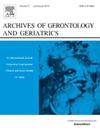痴呆患者死亡率的危险因素:系统回顾和荟萃分析
IF 3.5
3区 医学
Q2 GERIATRICS & GERONTOLOGY
引用次数: 0
摘要
背景:痴呆症患者的死亡风险增加。本系统综述旨在全面更新痴呆症患者死亡危险因素的现有证据。方法检索PubMed、Embase、Web of Science、中国知识基础设施、万方、中国科学期刊全文库等数据库,检索时间为建库至2024年10月。效应量用合并风险比(HR)和95%置信区间(CI)表示。采用Cochran’s Q检验和I2统计量分析异质性。结果共纳入33项符合条件的研究,涉及21个因素。结果表明,风险因素在痴呆是老年患者死亡率的调查(HR = 1.05, 95% CI: 1.03—-1.07),先进的年龄痴呆症状出现(HR = 1.05, 95% CI: 1.03—-1.07),男性(HR = 1.58, 95% CI: 1.49—-1.68)、高血压(HR = 1.21, 95% CI: 1.09—-1.34)、糖尿病(HR = 1.30, 95% CI: 1.09—-1.56),脑血管疾病(HR = 1.08, 95% CI: 1.00—-1.18),肺部疾病(HR = 1.57, 95% CI: 1.00—-2.47),CCI得分更高(HR = 1.11, 95%置信区间CI:1.00-1.22), CDR评分较高(HR = 1.47, 95% CI: 1.02-2.13)。非白人(HR = 0.68, 95% CI: 0.63-0.73)、抑郁症(HR = 0.88, 95% CI: 0.79-0.98)、血脂异常(HR = 0.77, 95% CI: 0.69-0.85)、AChEIs治疗(HR = 0.73, 95% CI: 0.66-0.81)、MMSE评分较高(HR = 0.95, 95% CI: 0.94-0.97)患者的风险较低。结论调查时的sage、痴呆症状出现时的年龄、性别、种族、高血压、糖尿病、血脂异常、抑郁、脑血管疾病、肺病、CCI、AChEIs、MMSE和CDR与痴呆患者的死亡率相关。本文章由计算机程序翻译,如有差异,请以英文原文为准。
Risk factors for mortality in individuals with dementia: a systematic review and meta-analysis
Background
Individuals with dementia had an increased risk of mortality. This systematic review aimed to comprehensively update current evidence on risk factors for mortality in individuals with dementia.
Methods
A database search of PubMed, Embase, Web of Science, China National Knowledge Infrastructure, Wanfang, and Chinese Scientific Journals Full-text Database was conducted from inception until October 2024. The effect size was expressed as a pooled hazard ratio (HR) and 95 % confidence interval (CI). The heterogeneity was analyzed by Cochran’s Q test and the I2 statistic.
Results
Thirty-three eligible studies with 21 factors were included. The results showed that the risk factors for mortality in individuals with dementia were advanced age at survey (HR = 1.05, 95 % CI: 1.03–1.07), advanced age at dementia symptom onset (HR = 1.05, 95 % CI: 1.03–1.07), male sex (HR = 1.58, 95 % CI: 1.49–1.68), hypertension (HR = 1.21, 95 % CI: 1.09–1.34), diabetes (HR = 1.30, 95 % CI: 1.09–1.56), cerebrovascular disease (HR = 1.08, 95 % CI: 1.00–1.18), lung disease (HR = 1.57, 95 % CI: 1.00–2.47), higher CCI score (HR = 1.11, 95 % CI: 1.00–1.22), and higher CDR score (HR = 1.47, 95 % CI: 1.02–2.13). Non-whites (HR = 0.68, 95 % CI: 0.63–0.73), and those with depression (HR = 0.88, 95 % CI: 0.79–0.98), dyslipidemia (HR = 0.77, 95 % CI: 0.69–0.85), treatment with AChEIs (HR = 0.73, 95 % CI: 0.66–0.81), and higher MMSE score (HR = 0.95, 95 % CI: 0.94–0.97) had a lower risk.
Conclusions
Age at survey, age at dementia symptom onset, sex, race, hypertension, diabetes, dyslipidemia, depression, cerebrovascular disease, lung disease, CCI, AChEIs, MMSE, and CDR were associated with mortality in individuals with dementia.
求助全文
通过发布文献求助,成功后即可免费获取论文全文。
去求助
来源期刊
CiteScore
7.30
自引率
5.00%
发文量
198
审稿时长
16 days
期刊介绍:
Archives of Gerontology and Geriatrics provides a medium for the publication of papers from the fields of experimental gerontology and clinical and social geriatrics. The principal aim of the journal is to facilitate the exchange of information between specialists in these three fields of gerontological research. Experimental papers dealing with the basic mechanisms of aging at molecular, cellular, tissue or organ levels will be published.
Clinical papers will be accepted if they provide sufficiently new information or are of fundamental importance for the knowledge of human aging. Purely descriptive clinical papers will be accepted only if the results permit further interpretation. Papers dealing with anti-aging pharmacological preparations in humans are welcome. Papers on the social aspects of geriatrics will be accepted if they are of general interest regarding the epidemiology of aging and the efficiency and working methods of the social organizations for the health care of the elderly.

 求助内容:
求助内容: 应助结果提醒方式:
应助结果提醒方式:


